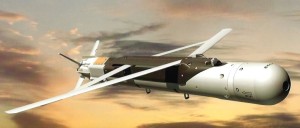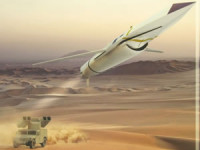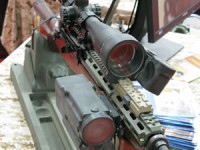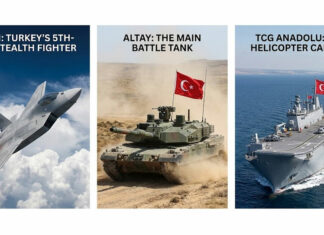

In recent years the role of armaments and weapons in military exhibitions is diminishing, reflecting the diminishing role of kinetic effects and the complex public perception as to their role in modern asymmetric warfare. Hence, the armaments and munitions presented at AUSA and the Modern Day Marine Expo emphasized focused precision effect and low collateral damage as outstanding qualities. This reflected the concern of manufacturers and users alike to those issues.
Examples included sniper rifles with precision fire control enabling the shooter to achieve higher precision at long range; weapons offering ‘man in the loop’ control, and ‘clean’ artillery projectiles or aerial munitions providing effective area saturation effect without the hazardous duds (unexploded ordnance – UOX), complying with the limitations derived from the Convention on Cluster Munitions (CCM).

Two manufacturers are offering new versions of munitions designed to cover a wide area but leave no UXO after the attack. At AUSA 2012 IMI unveiled at AUSA 2012 a new M-454 Super-High Explosive (S-HE) round, a 155mm artillery projectile fitted with two fuses. According to IMI, the M454 is more efficient than standard HE rounds, requiring less ammunition to complete each mission, thus reducing logistics footprint. The new round is compatible with all NATO 39, 45 and 52 Caliber Guns. Textron Systems is offering a new area attack weapon system that is highly effective against soft targets including light vehicles, enemy combatants and air defense sites. Textron Systems is also using the AP-BLU as a unitary warhead for the Guided Clean Area Weapon (CLAW), designed to engage soft targets in open area, attacked form an unmanned aerial vehicle.
Armies using the MLRS or HIMARS systems could find the new Ground-Launched Small Diameter Bomb (GL-SDB) an interesting prospect to modernize combat capabilities in compliance with the CCM. Boeing, the producer of SDB is planning to strap its bombs on existing M29 rockets emptied from their DPICM bomblets. Using the rocket motor to accelerate the bomb into a trajectory bringing it to an altitude and speed from where it can deploy its wings and glide to hit the designated as it would do when launched from an aircraft.

To enhance precision, while maintaining low cost, Boeing is developing the ‘Laser SDB’, utilizing the Laser JDAM guidance kits. ‘With the laser SDB pilots can now prosecute moving, relocateable and maritime targets travelling at highway speeds’ Boeing officials said. The first application of Laser SDB will be with the Air Force Special Operations Command (AFSOC) as the US Air Force plans to equip the new AC-130W ‘Stinger II’ gunships with this capability.
Boeing is also promoting new ideas about future weapons supporting expeditionary naval and ground forces. Among these conceptual designs is the Joint Air-Breathing Multi-role Missile (JABMM), extending the strike range of ground-launched weapons well beyond the range of rocket-propelled weapons. Such weapons could be deployed on surface combatants such as the Littoral Combat Ship (LCS) or carried on tactical vehicles supporting expeditionary ground forces, airborne or Marine Corps.

Supporting future amphibious assault, the Marine Corps will have to rely on precision artillery fire delivered from the sea, by the Navy warships. However, today’s destroyers are armed with 5“ (127mm) guns that are not designed to provide precision fires. Such capability will be fielded with the Zumwalt class (DDG-1000) guided missile destroyers currently under construction, that will be equipped with 155mm Advanced Gun Systems (AGS) firing specially developed Long Range Land Attack Projectiles (LRLAP). Both are developed by BAE Systems. With an effective range of 60 nautical miles, these guns will be capable of supporting Marine Corps units on the ground, from positions over the horizon. The 155mm LRLAP is a rocket assisted precision attack projectile using GPS/INS guidance techniques. The AGS is designed to fire up to 10 rounds per minute and has a storage capacity of 600 rounds.
While the AGS and LRLAP offer great future capabilities, the Navy plans to have only three such vessels. Hence the need to upgrade the current Mk45 Mod 4 5” gun system operational on DDG 51 guided missile destroyers and CG-47 guided missile cruisers. BAE Systems is developing such capability under the 5” Standard Guided Projectile (SGP) program. A sabot version of the 5” SGP projectile will also be compatible with the 155mm howitzers, enabling Marine and Army Artillery Corps to engage targets with high precision.
A futuristic weapon that has already passed the concept definition is the electromagnetic rail gun. A prototype developed by General Atomics Electromagnetics system (GA-EMS) group for the Office of naval Research has successfully performed initial firings at the Naval Surface Warfare Center at Dahlgren, VA. And at the Army Dugway Proving Ground in Utah. The gun is designed to deliver significantly higher muzzle energies that ever demonstrated in a tactical relevant configuration. The full scale ‘Blitzer’ EM Rail Gun System is currently undergoing a series of full energy tests and evaluation by the navy.

You don’t always need a big bang to win a fight. Sometime, all it takes is one bullet fired by a trained sniper, to deal with a serious situation. But snipers activities are often limited by weather conditions to medium or short range. In few years, snipers will be able to double their range and improve accuracy, therefore becoming even more useful in combat, as DARPA’s ‘One Shot’ system is fielded.

















